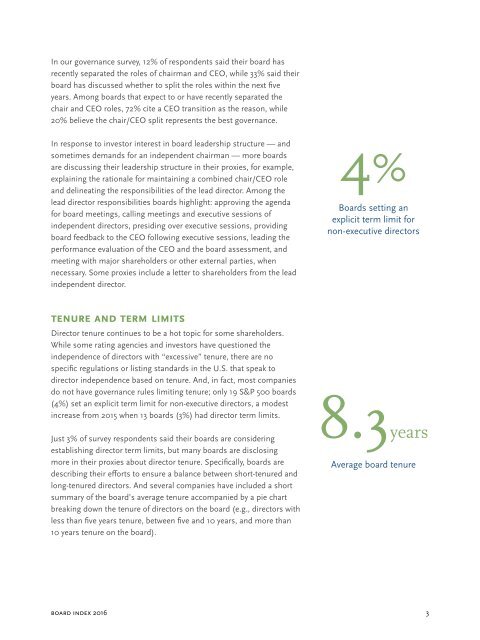Spencer Stuart Board Index
2ipnQXb
2ipnQXb
You also want an ePaper? Increase the reach of your titles
YUMPU automatically turns print PDFs into web optimized ePapers that Google loves.
In our governance survey, 12% of respondents said their board has<br />
recently separated the roles of chairman and CEO, while 33% said their<br />
board has discussed whether to split the roles within the next five<br />
years. Among boards that expect to or have recently separated the<br />
chair and CEO roles, 72% cite a CEO transition as the reason, while<br />
20% believe the chair/CEO split represents the best governance.<br />
In response to investor interest in board leadership structure — and<br />
sometimes demands for an independent chairman — more boards<br />
are discussing their leadership structure in their proxies, for example,<br />
explaining the rationale for maintaining a combined chair/CEO role<br />
and delineating the responsibilities of the lead director. Among the<br />
lead director responsibilities boards highlight: approving the agenda<br />
for board meetings, calling meetings and executive sessions of<br />
independent directors, presiding over executive sessions, providing<br />
board feedback to the CEO following executive sessions, leading the<br />
performance evaluation of the CEO and the board assessment, and<br />
meeting with major shareholders or other external parties, when<br />
necessary. Some proxies include a letter to shareholders from the lead<br />
independent director.<br />
4%<br />
<strong>Board</strong>s setting an<br />
explicit term limit for<br />
non-executive directors<br />
Tenure and term limits<br />
Director tenure continues to be a hot topic for some shareholders.<br />
While some rating agencies and investors have questioned the<br />
independence of directors with “excessive” tenure, there are no<br />
specific regulations or listing standards in the U.S. that speak to<br />
director independence based on tenure. And, in fact, most companies<br />
do not have governance rules limiting tenure; only 19 S&P 500 boards<br />
(4%) set an explicit term limit for non-executive directors, a modest<br />
increase from 2015 when 13 boards (3%) had director term limits.<br />
Just 3% of survey respondents said their boards are considering<br />
establishing director term limits, but many boards are disclosing<br />
more in their proxies about director tenure. Specifically, boards are<br />
describing their efforts to ensure a balance between short-tenured and<br />
long-tenured directors. And several companies have included a short<br />
summary of the board’s average tenure accompanied by a pie chart<br />
breaking down the tenure of directors on the board (e.g., directors with<br />
less than five years tenure, between five and 10 years, and more than<br />
10 years tenure on the board).<br />
8.3years<br />
Average board tenure<br />
board index 2016 3


